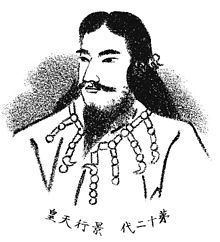Parents Hibasuhimenomikoto | Died 23 December 130 AD Successor Emperor Seimu | |
 | ||
Reign 71–130 AD (traditional) Burial Yamanobe no michi no e no misasagi (Nara) Children Yamato Takeru, Emperor Seimu Similar | ||
Emperor Keikō (景行天皇,, Keikō-tennō) was, according to legend, the 12th emperor of Japan. His reign is conventionally dated as 71–130 AD. He is also known as Ootarashihikooshirowake no Sumeramikoto.
Contents
Legendary narrative
Keikō is regarded by historians as a legendary emperor with little information about him. There is insufficient material available for further verification and study. The reign of Emperor Kinmei (c. 509 – 571 AD), the 29th emperor, is the first for which contemporary historiography is able to assign verifiable dates; however, the conventionally accepted names and dates of the early emperors were not to be confirmed as "traditional" until the reign of Emperor Kanmu (737–806), the 50th sovereign of the Yamato dynasty. The name Keikō-tennō was assigned to him posthumously by later generations.
His legend was recorded in Kojiki and Nihon Shoki, but the accounts of him are different in these two sources. In Kojiki he sent his son Yamato Takeru to Kyūshū to conquer local tribes. In Nihonshoki Keikō himself went there and won battles against local tribes. According to both sources, he sent Yamatotakeru to Izumo Province and eastern provinces to conquer the area and spread his territory.
According to traditional sources, Yamato Takeru died in the 43rd year of Emperor Keiko's reign (景行天皇四十三年). The possessions of the dead prince were gathered together along with the sword Kusanagi; and his widow venerated his memory in a shrine at her home. Sometime later, these relics and the sacred sword were moved to the current location of the Atsuta Shrine. Nihonshoki explains that this move occurred in the 51st year of Keiko's reign, but shrine tradition also dates this event in the 1st year of Emperor Chūai's reign.
The actual site of Keikō's grave is not known. This emperor is traditionally venerated at a memorial Shinto shrine (misasagi) at Nara.
The Imperial Household Agency designates this location as Keikō's mausoleum. It is formally named Yamanobe no michi no e no misasagi.
Consorts and children
Empress(first): Harima no Inabi no Ooiratsume (播磨稲日大郎姫), daughter of Wakatakehiko (若建吉備津日子)
Empress(second): Yasakairihime (八坂入媛命), daughter of Yasakairihiko (八坂入彦命)
Mizuhanoiratume (水歯郎媛), daughter of iwatsukuwake (磐衝別命), younger sister of Iwakiwake (石城別王)
Ikawahime (五十河媛)
Abe no Takadahime (阿倍高田媛), daughter of Abe no Kogoto (阿倍木事)
Himuka no Kaminagaootane (日向髪長大田根)
Sonotakehime (襲武媛)
Himuka no Mihakashihime (日向御刀媛)
Inabinowakairatsume (伊那毘若郎女), daughter of Wakatakehiko, younger sister of Harima no Inabi no Ooiratsume
Igotohime (五十琴姫命), daughter of Mononobe no Igui (物部胆咋宿禰)
